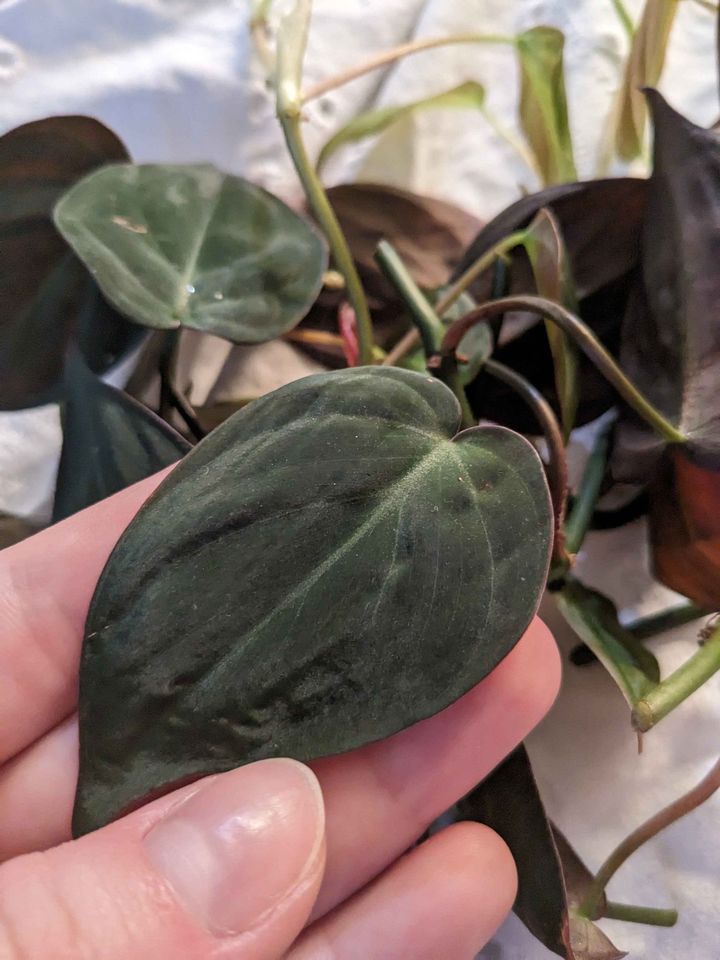Basic Information
The Philodendron Micans is a beautiful variety of Philodendron that is native to the tropical regions of Mexico and the Caribbean. It is known for its soft, heart-shaped leaves and its trailing growth habit. This plant has become increasingly popular as a houseplant but can be quite difficult to find in some areas. If you are able to get your hands on one, you won’t regret it! Philodendron Micans look great in hanging planters or climbing moss poles or trellises. Like other philodendron varieties, it is low-maintenance and easy to care for.



Light
Philodendron Micans is a plant that needs six to eight hours of bright, indirect sunlight daily. These plants are used to getting dappled light that filters through jungle canopies in their native tropical America. Too much light can cause sunburn, which yellowing leaves or brown spots can identify. During the winter season, when indoor sunlight is limited, it can benefit from some outdoor time in a sheltered area. The plant should be kept in indirect light near a north- or east-facing window for more sunlight or away from direct light in a south- or west-facing window.
Water
Philodendron Micans is a plant that needs to be watered properly. You should water the plant only when the soil has almost dried out completely. Over-watering can lead to root rot, so it’s important to wait until the soil has nearly dried out before watering thoroughly. You should water the plant more frequently during the warmer months, but watering should be reduced in the winter. Wait until the top two inches of soil become dry before watering again. Planting your Micans pot with drainage holes is essential to avoid any potential root rot or fertilizer burn.
Tip: To prevent over-watering, it is recommended to use terra-cotta pots, which help to wick away excess moisture.
Soil
The ideal soil for Philodendron Micans should be loose, nutrient-rich, and well-draining. It’s recommended to use a mixture of organic materials, such as coco-coir, peat moss, or shredded leaves, along with materials that enhance drainage, such as pumice, wood chips, or coarse sand. This combination will create air pockets necessary for root development while preventing water retention. If the soil drains too quickly, repotting the plant into a compost-rich mixture with fewer drainage materials is advisable.
Temperature
Philodendron Micans is a tropical plant that grows best in temperatures between 65-80°F (18-24°C), which are typically found in most households. If the temperature drops below 55°F (13°C), it can harm the plant and stunt its growth or even lead to its death. So, it’s crucial to avoid placing it in areas that become too cold.
Humidity
Philodendron Micans plants grow best in humid environments with a humidity level between 65% to 80%. Although they can survive in standard household humidity levels, they grow faster in higher humidity levels. If you live in dry regions, using a humidifier can help maintain the desired humidity level and keep your plant healthy.
Fertilizer
During the active growing seasons of spring and summer, it’s advisable to fertilize Philodendron Micans twice a month. You can use suitable fertilizers like a ¼-diluted fish emulsion with iron or a ¼-diluted complete liquid fertilizer. Another option is to top-dress the plants with compost, such as worm castings, which can slowly release nutrients to the roots.
Growth Rate
The Philodendron Micans is a strong and fast-growing plant that can develop large leaves measuring over 4 inches in size and long stems. It is possible to trim or train it to climb around a trellis, making it a versatile addition to your home decor.
Pet Safety
Philodendron Micans is toxic if ingested, making it important to keep it away from pets
Grow in Semi-Hydro
- Philodendrons, celebrated for their lush foliage and adaptability, thrive in semi-hydroponic systems such as LECA/Pon, thanks to their resilient root systems and preference for consistent moisture.
- Shifting a Philodendron to a semi-hydroponic setting works well using a Nutrient Stagnant Wicking (NSW) method, providing a stable and effective environment for growth.
- Within the LECA/Pon environment, Philodendron roots adapt swiftly, effectively managing any early challenges in adapting to the NSW system.
- For nourishing Philodendrons in semi-hydro systems, a nutrient solution with a concentration around 800-1000ppm is optimal.
- Philodendrons are versatile in adapting to a range of temperature and humidity levels, making them ideal for various indoor settings.
- Regular care involves keeping an eye on the water level in the reservoir and periodically flushing the system to ensure the Philodendron’s healthy and consistent growth.
- If your Philodendron is a climber, it’s a must to look at our Moss Pole guide to have a proper set-up.
Tips
- Rotate the plant regularly to promote even growth.
- Trim the plant by cutting under the node for propagation.
- Consistently inspect leaves for pests and diseases.
- Sticky droplets on leaves are normal and not harmful.
- Water when the leaves droop, indicating the need for hydration.
- Use well-draining soil rich in organic matter for repotting.
- Employ creative staking techniques for vine support
By following these detailed guidelines, your Philodendron Micans will not only survive but thrive, adding lush, velvety greenery to your indoor space.
Happy planting! 🌱


